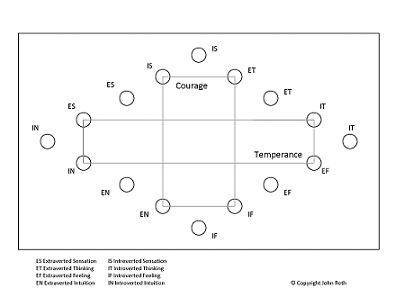Advanced Design Encounters Psychological Theory <ADEPT>
Successful teamwork innovation will respect many various kinds of personal contributions, even including paradoxically opposing orientations. Guidance from other, complementary areas of involvement can relate well with Design Thinking, potentially expanding strategic observation and action.
It is most often acknowledged that only a few habitual preferences will limit how persons may interact with others, in working circumstances and in social circumstances. Yet, a more encompassing scope of awareness represents an understanding to be desired and achieved, as difficult as this may be.
Alternative possibilities should be respectfully accommodated and situated – concerning organizational group interaction. The context and tone of individually expressed convictions might be considered appropriately, using advanced concepts of apprehension.
Creative virtuosity, in recognizing appropriate teamwork contributions, may lead toward more open, interactive, human-centered integration. Then, there could be a calling for a legitimate role as rain-maker, apart from a role as manager, coordinator, administrator, or facilitator. Maybe explaining the guiding effort as cooperative navigation would seem more acceptable.
Intentions here deliberately carry somewhat beyond the manner in which personal conduct may be most commonly seen and explained. Some additional advisement may be helpful. Certain exacting, conceptual, psychological determinations have been known for at least a hundred years. One particularly well-known model derives from observations by the renowned psychologist, Carl Jung. Intelligent associations would reach back in time much further. Connections would also reach out toward divergent world civilizations and cultures. There are distinctive categories of intrinsic, innate stances or functions, which are individually actualized through inward-focused or outward-focused tendencies. Rigorously extended determinations are becoming available, which carry immediate positive and practical implications – validating specific, characteristic positions and intonations.
Observations with greater authenticity, clarity, and value can be appreciated as being emergent. Otherwise, convictions can also be clouded by complicated, individualistic conditioning.
And, these kinds of inferences may be detected essentially in view of a reasonable preponderance of identifiable suggestive qualifications – rather than neatly decisive, deliberately quantitative markers or indicators. (Knowable imaginings are to be perceived differently than committed objectifications – perhaps more like auras than actualities.) Practice and judgment are implied.
One useful line of reasoning proposes the insight that any personal sensibility of awareness is actually a very fragile entity. Human consciousness has involved the adoption of layers and layers of characteristic, available memory mechanisms –as a means of identity protection. Such ingrained emotional and attitudinal devices can perform spontaneously, with an autonomous independence or insistence, as if in expectation of confrontation against situational circumstances. It can take many years of practice and many years of experience for a person to come to terms with one’s own inbred internal mechanisms and internal devices.
“In other words, relentless practice creates a database of experience that you can draw upon to make more enlightened choices.” . . . “Once you have gone through enough rapid innovation cycles, you will gain familiarity in the process and confidence in your ability to assess new ideas, and that confidence results in reduced anxiety in the face of ambiguity when you are bringing new ideas into the world.” --
(David Kelley & Tom Kelley | Creative Confidence | PP. 48-9)
A wide variety of actual (or imaginary) encounters may not really need to be considered as threatening at all, beyond habitual, initial impulses. More enriching ways of being can be permitted to flourish. But still, all kinds of interferences can get in the way, at any point in time.
“Through effort, practice, and continuous learning, you too can re-imagine your life and career, once you embrace creative confidence.” --
(David Kelley & Tom Kelley | Creative Confidence | P. 256)
An effective understanding of psychological dynamics may seem implicit with regard to Design Thinking, as a collection of techniques and disciplines to foster the most productive interaction and collaboration.
With regard to a deliberate detachment from any limited, accustomed observational space . . .
“David [Kelley] pointed out that Stanford – like all world-class universities, had Nobel-laureate quality researchers drilling deep into their own fields of knowledge. But he suggested that there are tremendous challenges in the twentieth century that aren’t going to be solved that way. . . . Rather . . . David proposed to Stanford to make at least a side bet in ‘going broad.’” --
(David Kelley & Tom Kelley | Creative Confidence | P. 27)
A well-balanced appreciation for appropriate differentiation is needed. Any notion of diversity for the pure purpose of diversity is not sufficient. It is possible to move from well-intended accommodation to more beneficial involvement. Diversity, in and of itself, can still enforce entrenched group expectations. So acceptance of authentic differentiation may represent something entirely different.
___________________________________________________________________________________
For my own purposes, I have been maintaining three Relational Integration Prisms <RIPs>, in trying to situate what I do in view of larger circumstances. A <Comprehension RIP> would describe subtle, interpersonal interactions. A <Progression RIP> would distinguish effective collaboration factors. A <Motivation RIP> would recognize aspects of traditional values and virtues, applied in practice.
___________________________________________________________________________________
One additional means of surfacing agreement may be promoted through bringing artistic expressions and performances directly into the work environment. Cultural cognizance is especially implicated.
Another positive realization may be the knowledge that one is never all alone in the virtual space of creative intentionality.
Creative adventurousness may sometimes seem uncomfortably remote, away from the more immediate here and now. Relatedness and purposefulness sometimes have a way of allowing new interconnections to appear as if from nowhere in the due course of time. In and of itself, waiting doesn’t always seem to work. A distracted gesture, or an unplanned interruption, can convey potent implications. Particular effects, such as those persistently represented through the traditional civil, cardinal virtues, may be found to carry an especially resonant impact. Intention will occasionally offer serendipitous, unpredictable, unexpected connectedness. Play on peripheral imagination.
Creative Confidence David Kelley and Tom Kelley


This effort represents the fifth contribution for MIX over a period of about three years. Again, Thank You to the Management Innovation eXchange community for the recognition registered now by over 100 like/approval indications for this piece -- as well as over 1000 like/approval indications for all five inter-related contributions. jR
- Log in to post comments
John,
I see much value in your your prisms system.
I also agree on your ambition to challenge common understanding of diversity.And the efficient use of it.
I will enjoy drilling down into the Materials and docs you shard.Thanks for the effort.
- Log in to post comments





You need to register in order to submit a comment.